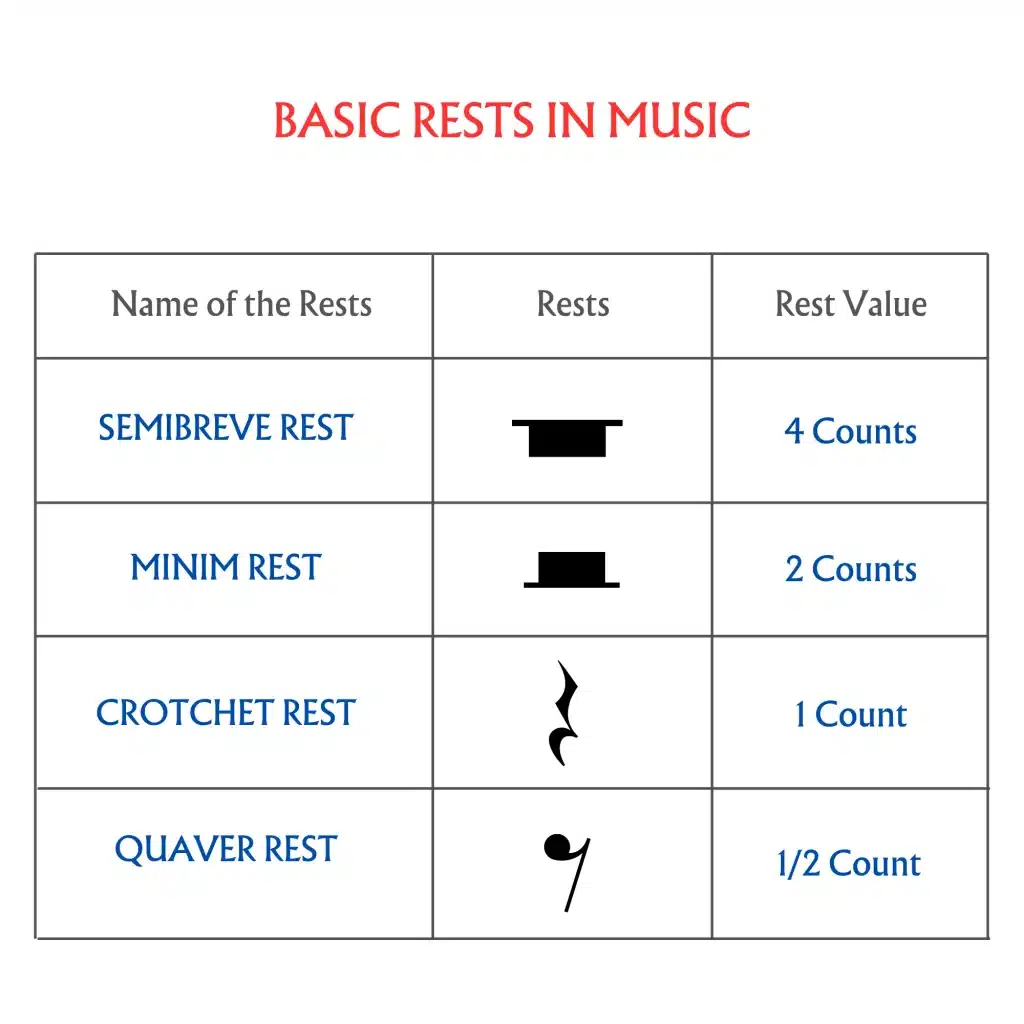It’s a vital skill for musicians, reading sheet music, I always say! Why, you may ask? Most importantly, it allows you to understand how music is structured. This will open up a whole new world of possibilities. I agree that it can feel like a drag at the beginning but if I can do it with my eyes shut, you can too. Let’s look into the essentials you need to learn to read piano or a violin well, just about any sheet music.
The Basics for Reading Sheet Music
So if you want to paint, you should know your ways around colors. If you want to cook, you must know about the ingredients. Likewise, free music sheets are all over the net but you need to know a few concepts to understand it.
Staff

5 lines and 4 spaces where musical notes are written on a sheet music is called the Staff or the stave lines. Notes written on these stave lines that represent different pitches. Each line and a space has a specific note.
Clefs
Treble Clef:

Here tht Treble clef is used for higher pitches. On piano sheet music, right hand notes are written on a treble clef. Violin sheet music is written on treble clefs. Voices such as Soprano, Tenor and Alto used treble notes.
Notes on Treble clef:

Like I’ve mentioned in the text, each line and a space has a specific note assigned to it. Notes on Treble Clef from bottom to top the notes read, E, G ,B, D, E, F,
Spaces have the notes F, A, C, E.

Hot Tip!
A common mnemonic to remember the notes on lines is “Every Green Bus Drives Fast.” the spaces spells out “FACE”
Bass Clef:

Treble clef is also called the G Clef and Bass Clef is also called the F Clef.
Notes on Bass clef:

From bottom to top the bass clef on a free sheet music notes read, G ,B, D, F, A. Spaces have the notes A, C, E, G. Now that we know the letter names of the notes on Treble and Bass Clefs, let us look into the types of notes and its note values written on sheet music.

Hot tip!
A common mnemonic to remember the notes on lines is “Good Boys Don’t Always .” And for spaces “All Cows Eats Grass”
What are the Notes on the Musical Staff?
Notes are the musical sounds written on the staff. It represents how low or high they sound. There are different types of notes on the basis of how long it lasts.

How to read Rhythms?
Understanding the note values is necessary to understand the concept of rhythms in music.
Note Values

Wondering what note value means? It is the length of a note i.e. how long it should be sung or played for. We will learn four basic note values required for learning to read sheet music. These are Semibreve , Minim, Crotchet, Quaver. Here is a chart that explains the note values of each note mentioned above clearly.
You can practice counting these notes with free sheet music available online.
Rests

Rests? Let me tell you something. Without rest a melody will not make any sense. Rests indicate silence in music. Rests also have values which tell =s us how long it needs to be paused for. We have Semibreve rest , Minim rest, Crotchet rest, Quaver rest, etc. you can find rests as much as notes on sheet music.
Once you’ve identified the Clef and the kinds of notes that’s written on any sheet music, now you should look for the time signature. The musical symbols on a piano sheet music is not that different from a violin sheet music.
Time Signature

It tell us the number of beats in a measure as well as the types of notes that can be found in that written piece of music. Time Signatures consists of 2 numbers.
Top number shows the number of beats in a measure and the bottom number types of notes and note values.
For example, 2/4 time signatures will have two crotchet beats per measure.
What’s this Measure that we keep talking about?
Measures and Bar Lines

Notice this line between notes that are dividing this Piano sheet music? These are called Bar Lines. Bar lines are used to measure the number of beats that are laid out by the time signature. This number of beats within the bar lines is called a Measure. These measures help organize the rhythms and structure melodies into sensible pieces of music.
After having learnt all these concepts, it’s time to learn to read pitches in sheet music.
Key Signatures

You will find the Key Signatures right next to the clef symbol, for instance in a violin sheet music. It gives us the flats and sharps used throughout the piece of music.
Both major keys and minor keys have their own key signature. It helps establish the key of the musical piece.
After identifying these basic elements, you can now try reading pitches in sheet music. Once reading you have an idea about reading pitches on a piano sheet music and then start playing music effectively.
Few Tips for Reading Pitches on a Free Music Sheet
1. Begin with simple melodies. I would suggest scales. That is the best place to start. Notes in scales are in intervals of two and so it’s easier to identify pitches. Look into this article for more info. Solfege
2. This trick worked for me. Everytime i practiced, I would search for very simple melodies with simple rhythms and try to sight read it. Regular practice does help improve quickly.
3. Getting the tempo right is quite challenging. Use a metronome. This would help you keep a steady tempo.
4. Breaking down the piece into smaller sections can help you understand the pitches better.
5. Refer to free sheet music available online to improve reading skills. Online tutorials also offer tips visually for learning to read a violin sheet music or a piano sheet music or a guitar sheet music.
6. There are few music apps that can be fantastic practice tools. Apps like Musecore, SmartMusic or Sibellius. They are available for free online. Free sheet music is found abundantly in it.
To Summarize!
Every musician must learn to read sheet music. It is challenging, I agree! But I can assure you that proper understanding of basic elements like staff, clefs and notes, rhythms, key and time signature can make this process easy. Book a Free Demo with us today to learn to read Sheet Music.
FAQs
What is sheet music?
It is a written representation of what we play or sing but theoretically with musical symbols and notation.
How to read piano sheet music?
One can read piano sheet music by understanding basic concepts like staff, clefs, notes, rhythms etc.
Where to find free sheet music?
There are tons of websites like Free Scores or Sheet music- Free that let you download free sheet music.
How to write sheet music?
You can use a notation paper or music apps. Place the notes properly on the lines and spaces and add required symbols like clefs, key and time signatures to make the notation understandable.
How to read violin sheet music?
It's easier to read piano sheet music by understanding basic concepts like staff, clefs, notes, rhythms, time signature etc
How to transpose sheet music?
Determine the original and the key you want to transpose it to. You can shift each note by the interval between the keys. Do not forget to change or adjust the key signature
How to read guitar sheet music?
To read guitar sheet music by understanding basic concepts like staff, clefs, notes, rhythms, time signature, key signature etc.
Related blog: Easy Guide for Online Music Theory: Notation & Sight Reading































